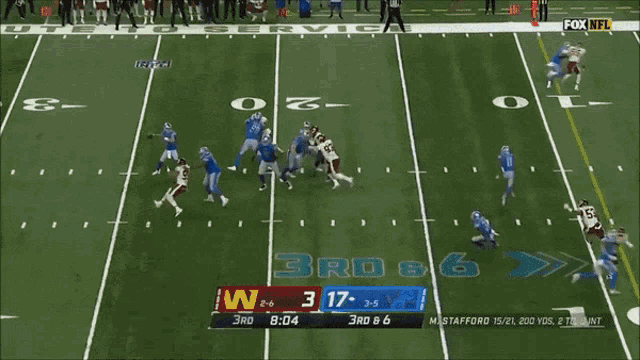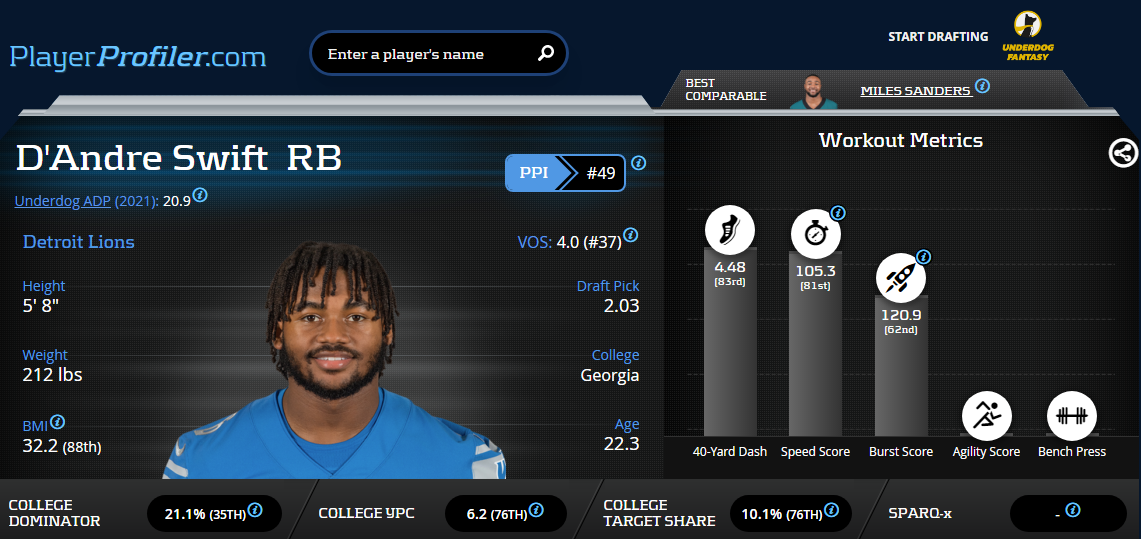Since 2010, only 20 of the 251 running backs selected in the NFL Draft would have finished in the top-12 for 2020 in their sophomore campaign. Yet every year, we look for those who can and will continue to dominate. There have been flags planted for Miles Sanders, Kerryon Johnson, and Leonard Fournette, all of which have left souls crushed and dreams dashed. However, can 2021 be different?
Two players give me hope to break into the top-12 in 2020: J.K. Dobbins and D’Andre Swift. Both had rookie average draft positions at 1.05, and both had strong finishes to their debut seasons. Is there one who is more likely to succeed with the other more likely to break your heart? Diving into the advanced stats and metrics, it becomes apparent.
Applying Hindsight
Volume has been vital for second-year backs to produce high-end numbers. Out of the 20 backs previously mentioned, only Tarik Cohen had less than 200 total touches, and only three – including Cohen – had less than 270 touches. However, volume wasn’t the only consistent factor with the majority of these sophomores. There were 16 who played 14 or more games, 19 had at least eight touchdowns and 15 had more than 40 receptions. They were healthy, able to get in the end zone and used in the passing game. How does this apply to D’Andre Swift and J.K. Dobbins?
Forecasting Dobbins’ future should be relatively more straightforward since he’s in the same system with a similar supporting cast. Forecasting Swift could be much more difficult. His utilization under offensive coordinator Darrel Bevell as the season came to a close was ideal, seeing at least a 56.4-percent Snap Share in six of his last seven games. Will it remain the same under new head coach Dan Campbell?
What we know about Campbell is he will be playing more of a CEO role for the Lions. He should allow offensive coordinator Anthony Lynn to call plays and run the offense. Lynn is a former running backs coach who had an uneven coaching tenure in terms of playcalling for the Chargers. When coming in as the head coach in 2017, he kept Ken Whisenhunt to call the plays. They finished middle of the road in plays per game in 2017, followed by No. 28 the following year. The Chargers fired Whisenhunt midway through the 2019 season with Shane Steichen taking over, but not without a heavy dose of input from Lynn. They still finished in the bottom half in 2019, but the game speed skyrocketed with Justin Herbert at the helm last season. They finished No. 1, running over 70 plays per game.
Underdog Best Ball Strategy: The Ultimate Guide ?
Draft Guide ➡️ https://t.co/K9FI7EKOJd
Cheat Sheet ➡️ https://t.co/nFmRpMtwea pic.twitter.com/fGiVHd3GGb
— RotoUnderworld (@rotounderworld) April 20, 2021
As a former running back, Lynn has typically emphasized a robust run game approach. However, during these four years, the Chargers – although No. 15 or worse in plays run in three of four years – were top-10 in pass attempts per game three times. Only in 2020 did they finish better than No. 19 in rush attempts per game. Swift owners: don’t freak out. The running backs still saw over 300 carries per season split between Melvin Gordon, Austin Ekeler and a few other ancillary backs.
Although the volume might not have been ideal on the ground, the usage through the air should have us drooling. Over the four-year stint, Lynn went heavy with his targets to the running backs. They never saw less than 100 looks, and the Chargers even led the league with 174 targets to the position in 2019. Philip Rivers could be a reason to believe this was the case, but he only crossed the 120 target threshold to his running backs two times prior to Lynn coming to town. With Lynn as the coach, he averaged over 151 per season. That may be because Rivers didn’t scramble, but Herbert ranked No. 10 among qualified quarterbacks with 55 carries and the RBs still cracked 100 total targets.

D’Andre Swift Takes a Reception for a Touchdown
With Jared Goff, who averaged 6.5 fewer rushing attempts per season than Rivers at quarterback, in Detroit, and no established pass-catchers currently on the roster of note outside of T.J. Hockenson, Swift should accumulate a healthy share of looks. The Lions have moved on from their defensive starters over the past two seasons, and DraftKings’ Sportsbook has them projected to only win five games. The negative Game Script should allow him to easily eclipse 80-plus targets and challenge the 100-target threshold by himself. If he is able to do so while maintaining last year’s 7.8 (No. 11) yards per reception average, it would add almost 150 fantasy points off receiving alone.
Can Swift Command 200 Carries?
Believe it or not, Detroit’s strength in 2020 was their offensive line, which they rarely invested in prior to 2016. However, 2020 was the fourth time in the team’s history where they spent two draft picks on the offensive line in the first four rounds. It’s the second time they’ve done so in the past four years, setting up the new regime with some power in the trenches. PFF has them graded at No. 13 in run blocking and No. 10 in pass blocking as they look to potentially add to the line and hope to have a healthier Halapoulivaati Vaitai (editors note: this article was written before the 2021 NFL Draft, where the Lions ended up drafting Penei Sewell at No. 7 overall).

Lions Offensive Line Opening Up Wide Lanes .
Although the Lions signed Jamaal Williams, we shouldn’t expect him to take too much of Swift’s workload. Adrian Peterson is leaving behind 168 total touches, and they lack other options in terms of being able to move the ball. Considering Lynn’s offenses have called a minimum of 340 handoffs in each year, 300 should be the floor we will see for the Lions in 2021, and Swift will have the majority. If there were any area where Williams could hurt Swift, it would be in the touchdown department. He mixed in with Aaron Jones as a red zone back for the Packers, logging six carries inside the five-yard line compared to 10 for Jones. This limited Jones’ upside considerably after he saw 17 such looks in 2019, which assisted him to the overall RB2 finish.
Lynn has used goal line backs as we saw with the Chargers. Melvin Gordon played in only 38 games from 2017-2019 and saw 29 red zone carries. Austin Ekeler, during the same span, played 46 games and logged only 15 red zone carries. Even in 2020, Joshua Kelley and Kalen Ballage saw 15 each compared to Ekeler’s two. The good news is red zone opportunities shouldn’t hinder D’Andre Swift‘s ability to finish in the top-12 among fantasy running backs. Swift only saw a 35.1-percent (No. 35) Red Zone Snap Share and still finished with ten touchdowns, even though over 22.0-percent of Peterson’s carries came from inside the 20-yard line.
What About Swift’s Reliability?
Detroit’s coaching staff was slow to bring up D’Andre Swift in his rookie year. He suffered a minor injury in camp that made them cautious not to bring him back too soon. He didn’t see 10 carries in a game until Week 6. Following a concussion suffered in Week 10, they held him out of additional games, though he passed the concussion protocol. It’s no surprise they were bringing him up slow since he was their future star and only potential offensive weapon in 2021 with Kenny Golladay being a free agent. But I don’t expect the current staff to hinder Swift’s progress moving forward. They’ve always put their best players on the field and should continue to do so with Campbell calling the shots. Swift has the talent and will have the opportunity to finish top-12.
The Case for Dobbins?
J.K. Dobbins is in an intriguing spot. There’s been one significant change which positively affects his situation, and no it’s not Mark Ingram going to Houston. One of the least talked about, yet most impactful moves of the 2021 offseason was the signing of guard Kevin Zeitler. Bradley Bozeman was a solid fill-in, but Zeitler should get the Ravens closer to where they were in 2019 when they had Marshal Yanda on the line. Although Dobbins had a 92.2 (No. 5) Run Blocking Efficiency rating, both Ingram and Gus Edwards saw a drop of over five points from 2019 to 2020. Zeitler should be able to give Dobbins even more room to run.

Kevin Zeitler is a Massive Addition for the Ravens .
The more considerable aspect for Dobbins is that he did everything you yearn to see in a running back. He had a position-leading 8.2-percent Breakaway Run Rate and a 30.9-percent (No. 9) Juke Rate. In addition, as Ingram’s involvement declined late in the season, Dobbins’ increased as he averaged almost 12 carries per game down the stretch. Even with Edwards re-signing, his carries will continue to climb as he takes over a more prominent role in this offense. If he averages 15 carries a game, it would put him around 250 for the season.
https://www.youtube.com/watch?v=y082sS1iCuc
Even if Dobbins’ efficiency does regress, 5.0 yards per carry at 250 attempts still has him breaking 1,200 rushing yards. Pointing out his red zone usage following the Week 7 bye makes him infinitely more enticing. From Weeks 1-6, he saw two carries inside the 20-yard line. From Week 8 onward, he saw 25 carries and scored eight touchdowns. He converted 88.9-percent of his rushing attempts inside the five into touchdowns. As previously mentioned, touchdowns play a large part in being a top-12 fantasy back.
Is Dobbins the Clear-Cut Winner?
There is one area of concern for J.K. Dobbins. Baltimore only targeted their tailback 50 times in 2020 and 51 times in 2019. Outside of the Titans, no other team targeted their back less than 60 times. On top of the lack of targets, he was only targeted twice in the red zone (once in the playoffs) and his 16.7-percent Drop Rate was the highest of any back who saw 15 or more total targets.
Verdict: Can Both Finish Top-12?
D’Andre Swift is undoubtedly a top-12 running back and potentially a top-five asset in dynasty. The same can’t be said for J.K. Dobbins. Variables won’t influence Swift’s value and he will continue to rise as a fantasy asset for years to come.
Swift is the better fantasy option moving forward.

Dobbins and Swift are both running backs to be desired. The choice is murky as to who’s the better long-term investment. While targets and touches can be sustainable and predicted, Breakaway Runs and Juke Rates cannot. Since 2016, there isn’t a single running back who had a Breakaway Run Rate of 7.0-percent or higher who could sustain the same level the following season. There are also few running backs who did the same with Juke Rate. Although we could see an increase in Dobbins’ workload, there is a significant chance we see a decrease in efficiency. Without the work in the passing game, it’s possible Swift finally creates a separation in value during the 2021 season.
Who do you prefer in Dynasty?
? D’Andre Swift
❤️ JK Dobbins pic.twitter.com/uIo9bwVl4g— RotoUnderworld (@rotounderworld) April 16, 2021





